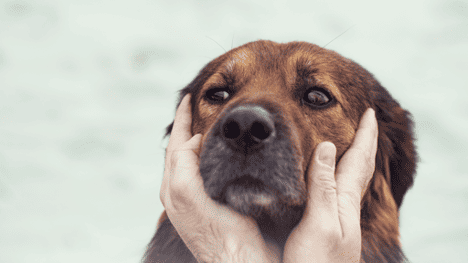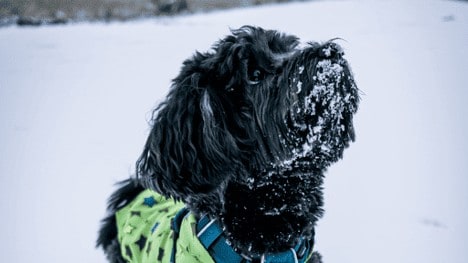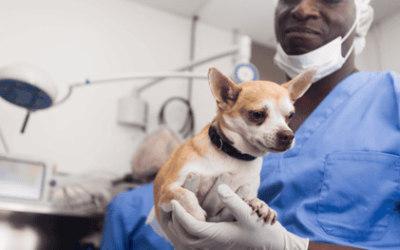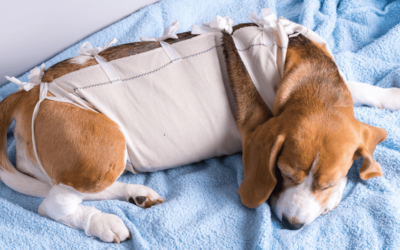How to Maintain a Dog’s Health & Safety in Cold Weather

Winter can be lovely, but our pets may have difficulties as the temperature decreases. Dogs, like humans, require specific care to stay warm and secure during the winter. Protecting your canine friend’s health is crucial during cold weather, whether you’re a seasoned pet owner or a new dog parent.
This thorough guide will cover all the information you need to keep your dog warm, safe, and healthy over the winter. We’ve compiled a list of helpful recommendations to assist you in navigating the winter wonderland with your four-legged friend, from providing proper shelter to protecting their paws and keeping an eye on their behavior.

What Temperature Is Too Cold for Dogs?
Simply put, there isn’t a universal answer to this question. The extent of cold-weather endurance varies among dog breeds. Short-coated dogs, pups, older dogs, and smaller canines are typically more sensitive to cold temperatures.
As a general guideline, if it’s too cold for you to comfortably spend the day outside, it’s definitely too cold for your pet. Pay close attention to your dog’s behavior and watch for indications of discomfort, such as shivering.
18 Tips on How to Maintain Your Dog’s Health in Cold Weather
1. Adequate Shelter
Your dog needs a warm, dry place to stay during the winter. If your dog spends time outside, make sure the house is well-insulated and has comfy bedding. To guard against cold and moisture, make sure the shelter is elevated off the ground. Straw or blankets could be used as additional insulation.
2. Monitor Outdoor Time
Dogs enjoy playing outside, but you should restrict their exposure to the cold weather. Shivering, weakness, and a decreased pace are indications of pain or hypothermia. It’s time to go indoors if your dog exhibits these symptoms. Always keep an eye on them when they play outside and consider their safety.
3. Dress Appropriately
For smaller or short-haired breeds, dog gear can be a lifesaver in the winter. Invest in a well-fitting, insulating dog coat or sweater to keep your dog comfortable during walks and other activities. Remember that not all dogs appreciate donning clothing, so give them time to gradually get used to it.
4. Protect the Paws
Cold surfaces and chemicals used on snowy roads might damage your dog’s paws. Boots or paw balms can be used to protect their feet. Paw balms offer a layer of protection and hydrate parched paw pads. Boots, on the other hand, provide total defense from the elements and toxins.
5. Adjust the Diet
The number of calories your dog needs can change in the cold. Think about changing their diet to maintain a healthy weight. Personalized advice based on your dog’s breed, age, and degree of activity can be obtained from your vet. A healthy diet that is balanced and adequate is crucial for their well-being.
6. Maintain Exercise Routine
Even in the winter, regular exercise is essential for your dog’s physical and psychological well-being. If it’s too cold to go outside, come up with some inventive indoor fitness plans. To keep their minds and bodies active, play games, utilize puzzle toys, or teach them new tricks.
7. Stay Hydrated
Contrary to popular belief, dogs still require a lot of water in the winter. Make sure they always have access to clean water, both inside and outside. Bring a water bottle and a foldable bowl for water breaks when engaging in outdoor activities.
8. Grooming Tips
Grooming is extremely important in the winter to help your dog maintain a healthy coat. When it’s cold outside, try not to over-bathe your pet and use moisturizing products to avoid drying out their skin.
9. Watch for Signs of Frostbite
Extremely cold weather raises severe concerns about frostbite. Keep an eye out for symptoms such as swelling, blisters, or darkened skin. Seek quick veterinary care if you have any concerns about your pet, and avoid keeping them in the cold for an extended period of time, especially when it’s windy.
10. Keep Up With Veterinary Care
All through the year, especially in the winter, regular veterinary checkups are essential. Make sure your dog has all the necessary shots and flea and tick prevention treatments. Regular veterinary appointments can aid in identifying and treating any health issues before they worsen.
11. Limit Exposure to Cold Winds
The delicate areas of your dog, such as their ears, nose, and paws, might be damaged by cold winds. Reduce their exposure to windy and drafty regions, especially when out for a stroll. Choose sheltered routes to protect them from the cold, and think about building windbreaks on your property.
12. Provide Warm Bedding
Make sure your dog has a cozy bed inside your house to cuddle up in when it’s cold outside. Warm pet pads or plush blankets are both excellent choices, and their sleeping place should be protected from chilly surfaces and drafts.
13. Use Safe Heating Options
Double-check that any heaters you use in your home are pet-safe and out of your dog’s reach. Avoid using radiators or space heaters that could burn you or your pet. Instead, look for heating solutions labeled as pet-friendly.
14. Dry Off After Outdoor Activities
After outdoor activities, properly towel-dry your dog, paying close attention to their paws and tummy. Damp fur can make them feel cold and uncomfortable. It’s also a wonderful opportunity for a warm snuggle session!
15. Protect Against Cold-Related Ailments
Canine arthritis and respiratory illnesses are made more likely by cold weather. To avoid these illnesses, keep them immunized and make sure they are warm and dry during the cold months.
16. Avoid Leaving Your Dog in a Cold Car
It’s really risky to leave your dog in a cold car. Temperatures can quickly drop, even with the windows cracked open. Bring your dog inside or use a good dog kennel inside the car if you must travel with them during the winter.
17. Be Mindful of Antifreeze
Antifreeze is toxic to dogs, which can be lethal if consumed. Spills should be cleaned up as soon as possible, and antifreeze containers should be kept securely out of reach. To be safe, keep your dog away from any potential antifreeze spills and usage locations.
18. Observe Behavior and Monitor for Changes
Pay more attention to your dog’s behavior and health throughout the colder months. Keep an eye out for any strange adjustments or signs of pain. Whenever something looks strange, trust your gut and speak to your veterinarian.
How Pet Insurance Benefits Your Dog’s Health?
Pet insurance can help take care of the stress of veterinary bills when your pet is not feeling well, especially in the event of unanticipated medical emergencies. Here are three plans from Odie Pet Insurance to consider:
Illness & Injury Plan
The Illness & Injury Plan from Odie includes emergency vet visits and overnight hospital stays to take the burden off of pet owners dealing with cold-related illnesses. You can also take advantage of 24/7 televet chats to discuss any concerns.
Accident Only Plan
The Accident Only Plan is helpful in the event your dog needs to be hospitalized or requires emergency care. It covers hospital stays, x-rays, scans, tests, and more.
Wellness Plan
Odie’s Wellness Plan is an add-on, available for purchase with any other Odie insurance plan. It will help you take care of your pet throughout the year with preventative treatments and wellness visits to avoid frostbite and other similar ailments in the winter.
FAQs
Is 10 Degrees Too Cold for a Dog?
For the majority of dogs, especially smaller breeds or those with short coats, 10 degrees Fahrenheit is too cold. It is best to keep them inside as much as possible and make sure they have warm clothing and a comfy shelter.
Is It OK for Dogs to Sleep Outside in Winter?
In the winter, sleeping outside is not advised because the cold can be harmful to pets. Inside your house, they should have a warm, dry place.
Is 0 Degrees Celsius Too Cold for a Dog?
Yes, dogs can get quite cold at 0 degrees Celsius, so additional care should be taken to keep them warm.
Is 15 Celsius Too Cold for a Dog?
Although 15 degrees Celsius is typically not thought to be excessively cold for dogs, you should check on their behavior and comfort anyhow.
Do Dogs Get Cold at Night?
Yes, dogs can get cold at night, particularly if they are sleeping outside. Make sure they have a warm, comfortable place to sleep inside.



